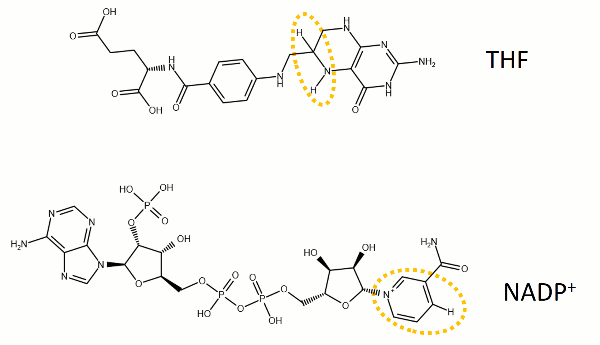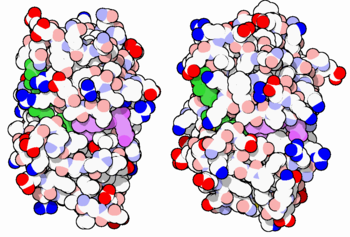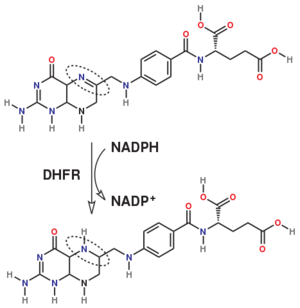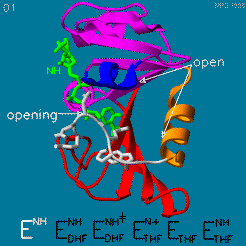Dihydrofolate reductase
From Proteopedia
| Line 26: | Line 26: | ||
== Structure and Function == | == Structure and Function == | ||
| - | <StructureSection load='' size='350' side='right' caption='' scene='82/82636/Dhfr_ternary/4'> | + | <StructureSection load='' size='350' side='right' caption='' scene='82/82636/Dhfr_ternary/4'>__NOTOC__ |
| - | __NOTOC__ | + | |
| - | + | ||
| - | + | ||
=== Fold and ligand binding === | === Fold and ligand binding === | ||
| - | DHFR from bacteria and vertebrates share a common fold featuring a <scene name='82/82636/Fold/1'>central beta sheet</scene> surrounded by <scene name='82/82636/Fold/2'>loops and alpha helices</scene>. The <scene name='82/82636/Fold/3'>ligands</scene> bind in similar locations in bacterial and vertebrate enzymes. The substrate (and the competive inhibitors) bind on one side of the beta sheet while the co-factor NADPH wraps around the sheet (around the C-terminal ends of strands as found in the classic [[Rossmann fold]] nucleotide binding site), with the nicotinamide moiety next to the substrate and the adenine moiety on the other side of the sheet. | + | DHFR from bacteria and vertebrates share a common fold ([http://www.cathdb.info/version/latest/superfamily/3.40.430.10 CATH], [https://scop.mrc-lmb.cam.ac.uk/term/3001255 SCOP]) featuring a <scene name='82/82636/Fold/1'>central beta sheet</scene> surrounded by <scene name='82/82636/Fold/2'>loops and alpha helices</scene>. The <scene name='82/82636/Fold/3'>ligands</scene> bind in similar locations in bacterial and vertebrate enzymes. The substrate (and the competive inhibitors) bind on one side of the beta sheet while the co-factor NADPH wraps around the sheet (around the C-terminal ends of strands as found in the classic [[Rossmann fold]] nucleotide binding site), with the nicotinamide moiety next to the substrate and the adenine moiety on the other side of the sheet. |
<jmol> | <jmol> | ||
Revision as of 17:02, 8 January 2022
The enzyme dihydrofolate reductase (DHFR) occurs in all organisms and has been particularly well-studied in the bacterium Escherichia coli and in humans[1][2][3]. It catalyzes the reduction of dihydrofolate to tetrahydrofolate, with NADPH acting as hydride donor. The human enzyme is a target for developing inhibitors used in anti-cancer chemotherapies[4], while the bacterial enzymes are targets for developing inhibitors as antibiotics. DHFR is a model enzyme for studying the kinetics, mechanism, and inhibition of enzymatic reactions and the underlying structure and conformational dynamics.
Contents |
DHFR occurs in all organisms and most cells
DHFR is found in all organisms. Some bacteria acquire resistance to DHFR inhibitors through expressing a second form of DHFR coded on a plasmid. The enzymes from E. coli (ecDHFR) and humans (hDHFR) have similar folds, while the plasmid-encoded enzyme has an unrelated fold. In humans, DHFR is expressed in most tissues[1], and there are two genes, DHFR and DHFR2/DHFRL1, the latter targeted to mitochondria[5]. Mice and rats lack the second gene but also show DHFR activity in mitochondria[6].
Reactions catalyzed
Dihydrofolate reductase (DHFR, 1.5.1.3 [2]) is an enzyme which uses the co-factor NADPH as electron donor. It catalyzes the reduction of as NADPH is oxidized to NADP+. The mammalian enzymes also accept folic acid as a substrate, reducing it to THF. This allows the use of folic acid, which is easier to synthesize than DHF or THF, to fortify food.[7][8]. Some bacterial enzymes also accept folic acid as a substrate [9] but it acts as a competitive inhibitor in the E. coli enzyme.
The folate is a form of the essential vitamin B9. Folate is not part of our natural diet (it contains dihydrofolate and tetrahydrofolate, sometimes as a poly-glutamate conjugate) but is bioavailable and simpler to synthesize.
Relevance
Tetrahydrofolate is an essential cofactor of one-carbon metabolism[10][11]. For example, it is required for turning homocysteine into the amino acid methionine, and for biosynthesis of dTTP, one of the four nucleotide building blocks of DNA. In these reactions, tetrahydrofolate is oxidized to dihydrofolate. To allow for multiple rounds of turnover, dihydrofolate has to be reduced again; dihydrofolate reductase is the enzyme that enables this. Like many common cofactors, tetrahydrofolate is not synthesized de novo in the human body. Instead, it is provided as vitamin B9 in a healthy diet, for instance through leafy vegetables (the name for folic acid come from e.g. Latin folio, leaf). Many countries fortify common food ingredients like flour with vitamin B9 (in the form of folic acid) to ensure sufficient dietary levels. As described below, DHFR also plays a role in reducing folic acid to the biologically active tetrahydrofolate.
In some cases, DHFR forms a complex with the enzymes that produce dihydrofolate, e.g. thymidylate synthase (TS)[12]. Both enzymes are required in the biosynthesis of pyrimidine.[13]
Structure and Function
| |||||||||||
See also
3D Structures of Dihydrofolate reductase
Dihydrofolate reductase 3D structures
Additional Resources
- For additional information, see: Cancer.
- See also Molecular Playground/DHFR.
References
Proteopedia Page Contributors and Editors (what is this?)
Michal Harel, Karsten Theis, Alexander Berchansky, Joel L. Sussman, Tzvia Selzer, Jaime Prilusky, Eric Martz, Eran Hodis, David Canner




